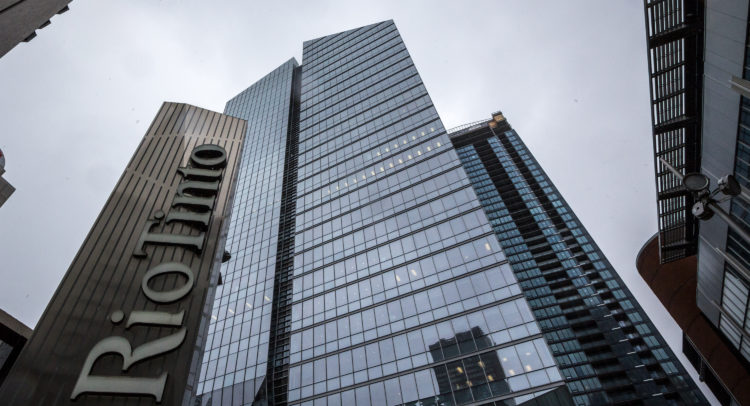Rio Tinto Group (RIO) shares are down 15.5% from the April 18 peak on strong headwinds for iron ore and other metals, but the base metal mining stock is still up more than 10% year-to-date. I am bullish on this stock as I believe that the main impediment to higher commodity prices is gradually disappearing, causing traders to return strongly to this stock.
Claim 50% Off TipRanks Premium and Invest with Confidence
- Unlock hedge-fund level data and powerful investing tools designed to help you make smarter, sharper decisions
- Stay ahead of the market with the latest news and analysis so your portfolio is always positioned for maximum potential
About Rio Tinto Group
Rio Tinto Group operates as a global mineral resource explorer, producing iron ore, aluminum (alumina and bauxite), copper, various industrial minerals (titania slag, borates and salt), gold, diamonds and other commodities such as molybdenum and silver.
Most of its business comes from iron ore, which accounts for more than 67% of Rio Tinto’s total consolidated sales in 2021.
Aluminum (alumina and bauxite) made up 19.3% and copper 5%.
The head office is in London, UK.
Factors Causing the Recent Iron Ore Plunge
The iron ore market was performing very well until a resurgence of the COVID-19 infection in China, which forced megacities like Shanghai and Beijing to reintroduce lockdowns and other restrictions to stem the spread of the virus, creating strong headwinds for the commodity.
With China being the world’s largest consumer of iron ore, restrictions imposed to contain the coronavirus have stifled much of global demand, reflected in price falls in recent weeks.
As a guide, iron ore 62% fines Fe-CFR (TIOc1) futures ($133.66 per ton at the time of writing) are down 17.3% from their April 4 peak.
Due to the headwinds mentioned above, economists have revised the commodity price downward, forecasting an 18.8% decline to $108.60 in the 12 months from current levels.
Meanwhile, this estimate does not consider recent improvements in China’s fight against the coronavirus resurgence. Therefore, the following factors should soon lead to a better iron ore price forecast and potentially act as a powerful catalyst for Rio Tinto’s stock price as the company’s business is mostly iron ore.
Iron Ore Outlook: Chinese Recovery in Progress
Declining COVID-19 infections have given way to regulators allowing commercial activities to resume in the metropolis of Shanghai after weeks of closure.
Airports are resuming a large number of flights for cargo and passengers. Since April 30, there has not been a positive case of the coronavirus among crew or shore personnel at Baiyun Airport (a key hub in south China’s Guangdong Province).
According to recent estimates from the National Health Commission, infection numbers in China are falling significantly, with Shanghai seeing a steady decline in daily new infections and Jilin province instead bringing the situation back under control.
Commodity Impacts on Rio Tinto
If, as it appears, the renewed outbreak of COVID-19 in China has caused the share prices of Rio Tinto and others to plummet on concerns about the slowdown in Chinese growth, then the recovery should follow once the health crisis wanes.
In addition, the 15-basis point cut in the People’s Bank of China (PBOC) 5-year loan rate on May 20 (the highest since 2019), should provide strong support for the demand for iron ore and other commodities, besides helping the Chinese economy during the worst of the COVID-19 outbreak for more than two years.
The Chinese central bank’s rate cut was welcomed by commodity markets as base metal prices rose on May 20, including shares of Rio Tinto (+2.37%) and other big miners.
Concerning another 20% stake of Rio Tinto’s business, aluminum futures prices ($2,800 per ton) are expected to rise 15.8% to $3,242.96 per ton. The increase is expected in 12 months, triggered by the reopening of China’s economy and lower 5-year rates.
Rio Tinto will look to capitalize on higher iron ore and other metals prices, meaning the company could potentially exceed its $17.7 billion free cash flow and its underlying earnings of $21.4 billion, both were at all-time highs in 2021.
Balance Sheet & Dividend
As a result, the balance sheet, which appears solid given a weighted average cost of capital (WACC) of 4.9% versus a return on invested capital (ROIC) of 26.3%, should continue to improve for a higher likelihood of a dividend hike.
Comparing WACC and ROIC shows that the investment returns are more than it costs the company to raise the necessary cash.
Regarding its dividend in the past 12 months through April 21 (date of payment of the last semi-annual dividend), Rio Tinto has paid out a total of $10.4, yielding 15.58% at the time of writing. Of course, a higher dividend rate will have a positive impact on the stock price.
Wall Street’s Take
In the past three months, five Wall Street analysts have issued a 12-month price target for RIO. The company has a Hold consensus rating based on one Buy and four Hold ratings.
The average Rio Tinto Group price target is $92, implying a 30.07% upside potential.

Valuation
Shares are changing hands at $70.73 for a market cap of $112.69 billion as of this writing.
After a significant drop this year, this stock price is trading well below the midpoint of the 52-week range of $59.58 to $91.09, meaning it’s a lot cheaper than it was a few weeks ago, with a greater chance of better gains than when the stock is back in uptrend mode.
Conclusion
The resurgence of COVID-19 infections in China has pushed this mining stock lower in recent weeks, as investors were worried about the Chinese demand for base metals. Following the resumption of Chinese economic activity, metal prices and shares of Rio Tinto will surge again. Lower interest rates from the Chinese central bank will encourage a more favorable price environment for producers of base metals.
Discover new investment ideas with data you can trust.
Read full Disclaimer & Disclosure
















